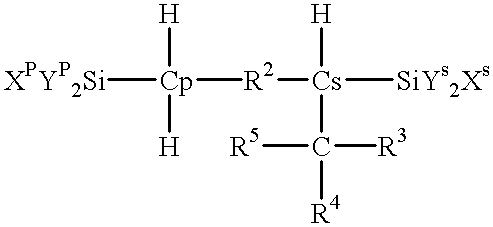Process for producing reactive silane oligomers
a technology of reactive silane and oligomer, which is applied in the field of process for making reactive silane oligomer, can solve the problems that none of the approaches disclosed in the prior art improves the miscibility of multi-component formulations, and achieves the effect of improving the degree of miscibility of multiple polymer components of such a coating composition and low viscosity
- Summary
- Abstract
- Description
- Claims
- Application Information
AI Technical Summary
Benefits of technology
Problems solved by technology
Method used
Image
Examples
example 1 (
Difunctional Silane Monomer 1)
A 2-neck 100 ml round-bottom flask was equipped with a magnetic stirring bar, heating mantle, solids addition funnel, and condenser. The condenser was fitted with a Claisen adapter and a polytetrafluoroethylene-clad thermocouple was inserted through the Claisen adapter and condenser to reach the liquid layer of the flask. The other arm of the Claisen adapter was connected to a 50 ml liquid addition funnel fitted with a Dewar condenser. The entire assembly was purged with nitrogen prior to the reaction and a positive pressure of nitrogen was maintained during the reaction.
The round bottom flask was charged with 4-vinyl-1-cyclohexene (22 g, 0.20 mole). The solids addition funnel was charged with 3g of Vazo.RTM. 64 initiator, supplied by DuPont Company of Wilmington, Del. The liquid addition funnel was charged with trichlorosilane (57 g, 0.42 mole). The condenser on the flask and the condenser on the solids addition funnel were cooled to -10.degree. C. Sti...
example 2 (
Difunctional Silane Monomer 2)
A mixture of 5-vinyl-2-norbornene (100 g, 0.83 mole), trichlorosilane (320 g, 2.36 mole) and platinum divinyl complex supplied by Gelest, Inc., of Tullytown, Penn. (0.6 g 2-3% in xylene) was heated in a pressure reactor at 115.degree. C. for 4 hours. The excess trichlorosilane was stripped under vacuum. A gas chromatography analysis showed the disilylated product purity to be greater than 96%. To the reaction product , a mixture of anhydrous methanol (115 g, 3.6 mole) and trimethylorthoformate (530 g, 5.0 mole) was added dropwise under vacuum. After the addition was complete, triethylamine (15 g, 0.15 mole) was added and the reaction mixture was refluxed for 2 hours. The volatiles were distilled off and the solids were filtered off. The reaction mixture was distilled at 80-100.degree. C. under a vacuum of 0.03-0.10 Torr, collecting about 10% of the first fraction (forecut). A gas chromatography, mass spectroscopy (K+IDS) and IH NMR analysis indicated th...
PUM
| Property | Measurement | Unit |
|---|---|---|
| polydispersity | aaaaa | aaaaa |
| molar ratio | aaaaa | aaaaa |
| polydispersity | aaaaa | aaaaa |
Abstract
Description
Claims
Application Information
 Login to View More
Login to View More - R&D
- Intellectual Property
- Life Sciences
- Materials
- Tech Scout
- Unparalleled Data Quality
- Higher Quality Content
- 60% Fewer Hallucinations
Browse by: Latest US Patents, China's latest patents, Technical Efficacy Thesaurus, Application Domain, Technology Topic, Popular Technical Reports.
© 2025 PatSnap. All rights reserved.Legal|Privacy policy|Modern Slavery Act Transparency Statement|Sitemap|About US| Contact US: help@patsnap.com



